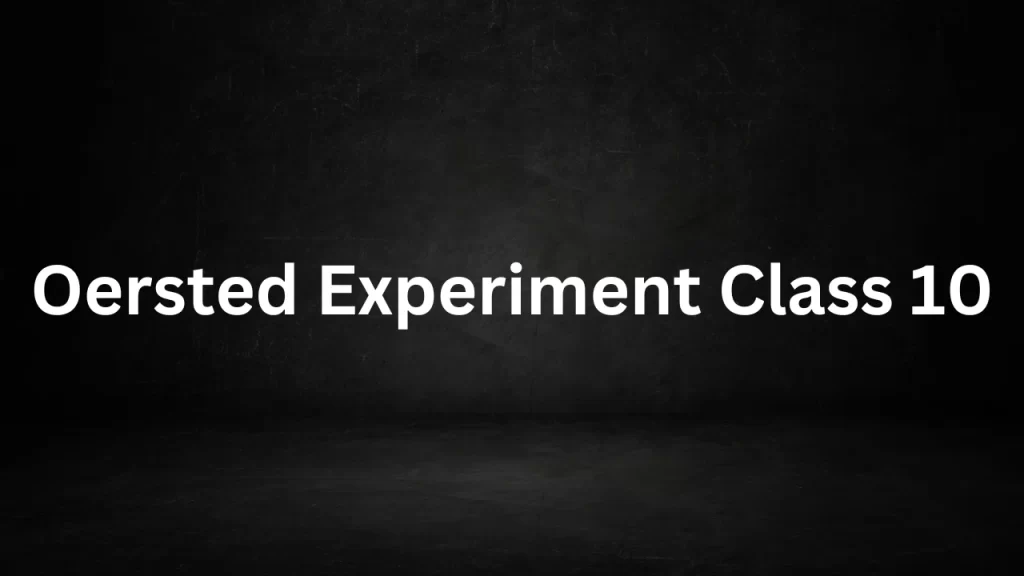Tag: faraday electricity
Oersted Experiment Class 10
Oersted Experiment Class 10: In the world of science, discoveries and experiments have often paved the way for groundbreaking revelations. One such experiment that holds immense significance in understanding the interplay between electricity and magnetism is the Oersted Experiment.
This experiment, named after the Danish physicist Hans Christian Oersted, was a pivotal moment in the history of physics. For Class 10 students, it serves as an excellent example to comprehend the fundamental principles of electromagnetism.

Oersted Experiment Class 10
The Background of the Oersted Experiment
In the early 19th century, scientists were still unraveling the mysteries of electricity and magnetism. The prevailing belief was that these two phenomena were entirely separate and unrelated. However, Oersted questioned this assumption and embarked on an experiment that would change the course of science.
The Experiment Setup
- Equipment: To perform the Oersted Experiment, you’ll need a few simple items: a straight wire, a compass needle, and a battery or electric current source.
Procedure:
a. Secure the wire so that it is parallel to the surface of a table or another stable surface.
b. Place the compass needle near the wire but not touching it.
c. Complete the circuit by connecting the wire to a battery or a power source to allow current to flow through it.
The Unexpected Observation
As the electric current flowed through the wire, something extraordinary happened. The compass needle, initially pointing in a specific direction, deflected from its original orientation. Oersted observed that the compass needle moved and aligned itself perpendicular to the wire carrying the current.
Significance and Implications
Oersted’s experiment had profound implications:
- Establishment of Electromagnetism: The Oersted Experiment provided irrefutable evidence that there was a connection between electricity and magnetism. It shattered the prevailing notion that these forces were entirely separate, ushering in the era of electromagnetism.
- Electromagnetic Fields: The experiment introduced the concept of electromagnetic fields. The magnetic field generated by the current in the wire caused the compass needle’s deflection. This discovery laid the foundation for understanding how electric currents generate magnetic fields.
- Magnetic Effect of Electric Current: The deflection of the compass needle showcased the magnetic effect of an electric current. This phenomenon is now described by Ampere’s law, which quantifies the magnetic field produced by a current-carrying conductor.
Teaching Class 10 Students
The Oersted Experiment is an excellent educational tool for Class 10 students studying physics. It offers several learning opportunities:
- Conceptual Understanding: It helps students grasp the fundamental relationship between electricity and magnetism, a key concept in their physics curriculum.
- Experimental Skills: The experiment introduces students to practical laboratory work, reinforcing their scientific method skills.
- Historical Perspective: Learning about Oersted’s experiment adds historical context to the study of science, demonstrating how scientific knowledge evolves through experimentation.
Conclusion
The Oersted Experiment is a cornerstone in the study of electromagnetism. It transformed our understanding of the fundamental forces governing our universe and has paved the way for countless technological advancements. For Class 10 students, it serves as an engaging and enlightening introduction to the fascinating world of physics, sparking curiosity and inspiring future scientists and engineers.
Read More
- Sodium Chloride Molecular Weight
- Equivalent Weight Of CaCO3
- Benzoic Acid Molar Mass
- Sulfuric Acid Molar Mass
- Discrete Mathematics For Computer Science
Frequently Asked Questions (FAQs) On Oersted Experiment Class 10
1. What is the Oersted Experiment?
The Oersted Experiment is a physics experiment that demonstrates the relationship between electricity and magnetism. It was conducted by Hans Christian Oersted in the early 19th century and showed that an electric current in a wire can create a magnetic field.
2. Why is the Oersted Experiment important for Class 10 students?
The Oersted Experiment is important for Class 10 students because it helps them understand the fundamental connection between electricity and magnetism, a crucial concept in physics. It also introduces them to experimental techniques and the scientific method.
3. What materials are needed to perform the Oersted Experiment?
To conduct the Oersted Experiment, you will need a straight wire, a compass needle, and a battery or electric current source. You may also require connecting wires and a switch to control the current flow.
4. How is the Oersted Experiment performed?
The experiment involves setting up a wire parallel to a compass needle and passing an electric current through the wire. The deflection of the compass needle indicates the presence of a magnetic field generated by the current.
5. What does the deflection of the compass needle in the Oersted Experiment signify?
The deflection of the compass needle shows that an electric current produces a magnetic field around it. This observation is a fundamental principle in electromagnetism.